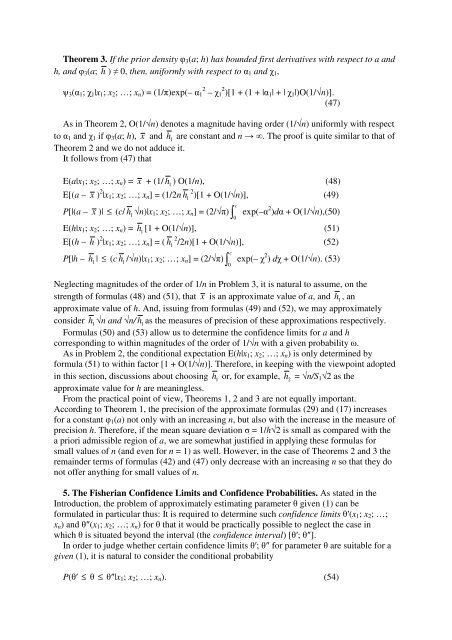kniga 7 - Probability and Statistics 1 - Sheynin, Oscar
kniga 7 - Probability and Statistics 1 - Sheynin, Oscar
kniga 7 - Probability and Statistics 1 - Sheynin, Oscar
You also want an ePaper? Increase the reach of your titles
YUMPU automatically turns print PDFs into web optimized ePapers that Google loves.
Theorem 3. If the prior density 3 (a; h) has bounded first derivatives with respect to a <strong>and</strong>h, <strong>and</strong> 3 (a; h ) 0, then, uniformly with respect to 1 <strong>and</strong> 1 , 3 ( 1 ; 1 |x 1 ; x 2 ; …; x n ) = (1/)exp(– 1 2 – 1 2 )[1 + (1 + | 1 | + | 1 |)O(1/n)].(47)As in Theorem 2, O(1/n) denotes a magnitude having order (1/n) uniformly with respectto 1 <strong>and</strong> 1 if 3 (a; h), x <strong>and</strong> h1are constant <strong>and</strong> n . The proof is quite similar to that ofTheorem 2 <strong>and</strong> we do not adduce it.It follows from (47) thatE(a|x 1 ; x 2 ; …; x n ) = x + (1/ h1) O(1/n), (48)E[(a – x ) 2 |x 1 ; x 2 ; …; x n ] = (1/2n h 2 1)[1 + O(1/n)], (49)P[|(a – x )| ≤ (c/ h1n)|x 1 ; x 2 ; …; x n ] = (2/) c0exp(– 2 )d + O(1/n),(50)E(h|x 1 ; x 2 ; …; x n ) = h1[1 + O(1/n)], (51)E[(h – h ) 2 |x 1 ; x 2 ; …; x n ] = ( h 2 1/2n)[1 + O(1/n)], (52)P[|h – h1| ≤ (c h 1/n)|x 1 ; x 2 ; …; x n ] = (2/) c0exp(– 2 ) d + O(1/n). (53)Neglecting magnitudes of the order of 1/n in Problem 3, it is natural to assume, on thestrength of formulas (48) <strong>and</strong> (51), that x is an approximate value of a, <strong>and</strong> h1, anapproximate value of h. And, issuing from formulas (49) <strong>and</strong> (52), we may approximatelyconsider h1n <strong>and</strong> n/ h 1as the measures of precision of these approximations respectively.Formulas (50) <strong>and</strong> (53) allow us to determine the confidence limits for a <strong>and</strong> hcorresponding to within magnitudes of the order of 1/n with a given probability ".As in Problem 2, the conditional expectation E(h|x 1 ; x 2 ; …; x n ) is only determined byformula (51) to within factor [1 + O(1/n)]. Therefore, in keeping with the viewpoint adoptedin this section, discussions about choosing h1or, for example, h2= n/S 1 2 as theapproximate value for h are meaningless.From the practical point of view, Theorems 1, 2 <strong>and</strong> 3 are not equally important.According to Theorem 1, the precision of the approximate formulas (29) <strong>and</strong> (17) increasesfor a constant 1 (a) not only with an increasing n, but also with the increase in the measure ofprecision h. Therefore, if the mean square deviation = 1/h2 is small as compared with thea priori admissible region of a, we are somewhat justified in applying these formulas forsmall values of n (<strong>and</strong> even for n = 1) as well. However, in the case of Theorems 2 <strong>and</strong> 3 theremainder terms of formulas (42) <strong>and</strong> (47) only decrease with an increasing n so that they donot offer anything for small values of n.5. The Fisherian Confidence Limits <strong>and</strong> Confidence Probabilities. As stated in theIntroduction, the problem of approximately estimating parameter given (1) can beformulated in particular thus: It is required to determine such confidence limits (x 1 ; x 2 ; …;x n ) <strong>and</strong> (x 1 ; x 2 ; …; x n ) for that it would be practically possible to neglect the case inwhich is situated beyond the interval (the confidence interval) [; ].In order to judge whether certain confidence limits ; for parameter are suitable for agiven (1), it is natural to consider the conditional probabilityP( ≤ ≤ |x 1 ; x 2 ; …; x n ). (54)









